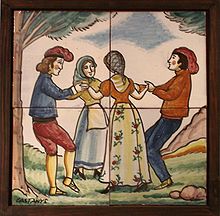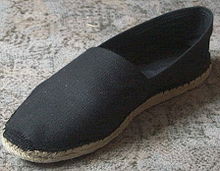Espadrilles
Espadrilles , originally called Espardenyes (in Catalan) or Alpargatas (in Spanish) in their Spanish homeland , are light summer slip- on shoes with an upper made of cotton or linen and a sole made of knotted plant fibers (flax, hemp ).
history
This shoe model was originally made and worn mainly in Spain and southern France . The word espadrilles comes from Provencal ( Occitan ). Presumably it is due to the esparto grass (steppe grass ) originally used for the sole . In his original Spanish homeland (it is assumed that the shoe originated in Mallorca ), these shoe models are accordingly called Espardenyes (in Catalan ) or Alpargatas (in Spanish ).

Meanwhile, there is a well-known summer shoe model, available in all possible body colors and occasionally falsely Espandrillos is called. Espadrilles came into fashion as a summer season item in German-speaking countries in the 1980s and were mainly worn by young people. In the same decade, cheap imports from Asia led to tough competition with the original European manufacturers, which led to a sometimes dramatic drop in prices.
properties
Espadrilles are barefoot shoes for both sexes and children. As distinct "summer shoes", they do not withstand any damp ambient conditions. An improvement in the resistance to damp surfaces was achieved by completely or at least partially covering the tread of the hemp sole with a thin layer of rubber. However, due to the constant bending load and the difficult attachment to the coarse plant fibers of the main sole, this begins to partially loosen after a short time and then tears off sooner or later.
They are very breathable due to the air-permeable and absorbent materials . In addition, they are also very light, but offer the foot hardly any support, no support and only minimal cushioning. Due to their simple structure (the natural fabric shaft is sewn to the sole with a very coarse overlock seam ), these shoes are low-priced products. Since the rear part of the shaft can simply be folded inwards onto the sole, espadrilles are also used as slipper-like slip-on shoes.
variants
Well-known designer labels and popular brand companies brought espadrilles-like models with imprints in brand colors (for example at Tommy Hilfiger ) or with a leather shaft at correspondingly higher prices. The best-known manufacturer of leather espad grooves that are closest to the classic original is the Alicante-based label Lika Mimika.
In 2005, the summer collections of well-known fashion labels ( Hermès , Ungaro , Marc Jacobs , Louis Vuitton ) included numerous women's canvas shoes with wedge heels on the subject of “Riviera High Society Shoe” or “Dolce Vita Espadrilles”. Not only the introduction of the heel, but also an additional lacing on these ladies' summer shoes still give an idea of the model's origin, but these shoes are no longer part of espadrilles.
Espadrilles / Espardenyes in folk song and folk art
In the folk song and folk art of the Catalan-speaking regions, the espadrilles, mainly called Espardenyes , play an important, almost existential role. An example of the former is the Valencian folk song Albaes 'Morgenstandschen'. Here is a verse specifically from the Espardenyes :
| verse | Valencian | German |
|---|---|---|
| 1 |
A la vora del riu, mare, |
Mother, |

If one interprets this verse from the entire context of the song (the moon envies the girl for her love etc.), the lost espardenyes symbolize the girl's “innocence”, which she has lost in the river mentioned in the song.
The Espardenyes are classically an element of the rural Catalan folk costume . This is also evidenced by the ideal typical ceramic art with a Sardana motif. Two young couples in Catalan peasant clothes dance the sardana. The men wear Espardenyes as footwear . The pronounced spread of Espardenyes in the Catalan peasant folk culture (folk song, folk dance, folk art) suggests that this type of shoe emerged in the peasant environment of the Catalan countries ( Catalonia , Valencia and the Balearic Islands ).
Linguistic
- Espadrilles are used in English-speaking countries as an umbrella term for canvas shoes with hemp or straw soles, with Mediterranean and South American associations being an integral part of the term.
- Canvas shoes with flax or grass soles are common in Spain than Alpargatas referred. In tourist areas, however, the term espadrilles is also known, probably due to the influence of the fashion industry or because tourists use this term when looking for this product.
- The traditional local footwear used by small farmers in Venezuela is also known as Alpargatas .
Trivia
- Like Grace Kelly, Sophia Loren wore espadrilles in numerous films of the 1950s. Annette Bening walked through the landscape of the Fiji islands in the film Perfect Love Affair .
- In the Miami Vice series , shot from 1985 to 1989, the protagonists Sonny Crockett, played by Don Johnson , and Rico Tubbs, played by Philip Michael Thomas , very often wore espadrilles.
- The cartoon character Gaston by the draftsman André Franquin wears blue espadrilles with red socks in all episodes.
literature
- Linda O'Keeffe, Andreas Bleckmann (photos): Shoes. A tribute to sandals, slippers, high heels . Ullmann, Potsdam 2011, ISBN 978-3-8331-6283-1 (English: Shoe . Translated by Manfred Allié, Gabriele Kempf-Allié).

